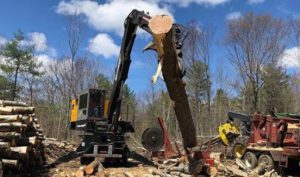50% of drinking water in the US comes from forested landscapes. That’s just one key reason why managing forest land is important to maintain water quality in Maine and New Hampshire. Following the 1970s Clean Water Act, most states follow forestry best management practices (BMPs) to help landowners, foresters, and loggers to safeguard water quality by controlling threats and pollution.
If you own land or are part of forest management projects, you should familiarize yourself with the BMPs.
Best Management Practices (BMPs)
Forestry BMP assures that equipment and tools used in silvicultural and harvesting activities don’t push sediment into waterways or contribute to the erosion of water stream banks. There are several forest management practices and techniques that every landowner and professionally associated with forest management must learn.
BMPs include log landings, stream crossings, constructing forest roads, planning, and stream buffers. Many states developed BMPs in the 1970s to urge loggers and forest managers to protect water quality in silvicultural activities. Most states follow similar techniques, and they all evaluate, adapt, test, and revise their practices over time.
Maine Forest Action Plan
The largest undeveloped forestland east of the Mississippi River lies in Maine. 90% of Maine’s land remains forested and undeveloped, despite the wood harvesting taking place more or less continuously for more than 200 years. The state has maintained forest biodiversity and has a long history of private land management and a long tradition of public access to land unless posted as no trespassing.
Maine’s Forest Action Plan plays a key role in forest management practices. It informs residents about the trends and conditions of the forest economy. The plan caters to indicators, criteria, threats, and opportunities in the forest economy.
New Hampshire Forest Action Plan
New Hampshire’s plan follows statewide planning that started in 1952 to develop a forest-focused policy. The plan prioritizes the conservation of forest landscapes, protects forests from threats, and enhances benefits from forests and trees.
 Forestry BMPs Techniques
Forestry BMPs Techniques
Following are major categories of best management practices and techniques used by most of the states in forest management.
Pre-Harvest Planning
Tree cutting and transportation can disrupt watersheds, but BMPs minimize the turbulence and protect water quality. Some BMPs are applied to different phases of wood harvesting, including planning, creation of landings, skid trails, cutting and construction, and design of roads.
Pre-harvest planning is an important practice because forethought allows professionals to avoid any problems in the watershed. In the absence of planning, you may impair the natural water filtration leading to flooding, erosion, and diminishing water quality. The pre-harvesting plan includes aerial photographs, soil surveys, topographic maps, and land assessments to make an informed decision.
Streamside Management Zones
These management zones are important and require special BMP consideration. Riparian management or streamside management zones are the areas of vegetation that safeguard and envelop woodland waters. BMPs in these zones locate infrastructure to avoid soil exposure and make sure they don’t harvest in these zones to promote the longevity of tree species.
Forest Wetland Protection
Wetlands support wildlife and protect water quality. Employing BMP to wetland allows you to enjoy no-cost services and protection. BMP techniques include avoiding landings and road construction in wetlands, intensive activities, and disposing of slash in these areas.
Road Construction & Maintenance
Poorly designed, maintained, and constructed roads could cause pollution, alter water flow and increase erosion. By putting some forethought into planning, you can save money and protect the quality of water. BMPs guide this planning phase to protect woodland and design and construct roads in the dry season to avoid compaction and rutting of wet soils.
BMPs also help avoid construction during fish spawning because sediment can bury fish eggs in water. Poorly planned and timed construction can wipe out fish reproduction in woodland. You can employ better soil stabilization techniques with BMPs, including sediment capture practices to capture soil.
Timber Harvesting
Timber harvesting is part of forest management that involves cutting and preparing trees for transportation to the sawmill. BMPs inform professionals to make better decisions that sustain the ecosystem and save money. However, BMPs need to be flexible enough to respond to changing dynamics.
Revegetation and Erosion Control
Replanting or revegetation is an effective technique to achieve restoration. It protects water resources and saves time and money on enhancing wildlife, beauty, and health of woodland. When re-establishing the plan, consider these BMPs:
- Introduce native plants and avoid non-native and invasive species.
- Loosen the soil and inspect soil quality before seeding.
- Revegetate and remove unnecessary logging roads, skid trails, and landings.
Fire Management
Fire plays a key role in woodlands, but it can also damage soil and remove vegetation. Prescribed fire management employs a plan to carefully select fire locations and control soil erosion using BMPs. BMPs also include employing fire breaks in streamside zones and avoiding chemical retardants near waterways. The technique also involves soil stabilization to maintain soil erosion until the land recovers.
Forest management requires a full range of services from a variety of professionals. William A. Day Jr. & Sons is a team of trained loggers based in Maine and New Hampshire. We can offer support and guidance relating to logging, firewood, and trucking services as part of your forestry services project. Contact us for more details.
